The Development of Honey Recognition Models Based on the Association between ATR-IR Spectroscopy and Advanced Statistical Tools
Abstract
:1. Introduction
2. Results
3. Discussion
3.1. Harvesting Year Differentiation
3.2. Botanical Differentiation
3.3. Geographical Discrimination
4. Materials and Methods
4.1. Sample Description
4.2. Vibrational Spectroscopy Analysis and ATR-FTIR Spectroscopy
4.3. Statistical Treatments
5. Conclusions
Author Contributions
Funding
Institutional Review Board Statement
Informed Consent Statement
Data Availability Statement
Conflicts of Interest
References
- Gomez-Barez, J.A.; Garcia-Villanova, R.J.; Elvira-Garcia, S.; Rivas-Pala, T.; Gonzalez-Paramas, A.M.; Sanchez-Sanchez, J. Geographical discrimination of honeys through the employment of sugar patterns and common chemical quality parameters. Eur. Food Res. Technol. 2000, 210, 437–444. [Google Scholar] [CrossRef]
- Serra Bonvehi, J.; Ventura Coll, F. Characterization of Citrus Honey (Citrms spp.) Produced in Spain. J. Agric. Food Chem. 1995, 43, 2053–2057. [Google Scholar] [CrossRef]
- Davies, A.M.C. Amino acid analysis of honey from eleven countries. J. Apic. Res. 1975, 14, 29–39. [Google Scholar] [CrossRef]
- Amiot, M.J.; Aubert, S.; Gonnet, M.; Tacchini, M. Honey phenolic compounds: A preliminary study on their identification and quantitation by families. Apidologie 1989, 20, 115–125. [Google Scholar] [CrossRef]
- Anklam, E. A review of the analytical methods to determine the geographical and botanical origin of honey. Food Chem. 1998, 63, 549–562. [Google Scholar] [CrossRef]
- Chin, N.L.; Sowndhararajan, K. A review on Analytical Methods for Honey Classification, Identification and Authentication. In Honey Analysis—New Advances and Challenges; de Alencar Arnaut de Toledo, V., Dechechi Chambó, E., Eds.; IntechOpen: London, UK, 2020. [Google Scholar]
- White, J.W.; Riethof, M.L.; Subers, M.H.; Kushnir, I. Composition of American Honeys. US Dep. Agric. 1962, 1261, 1–124. [Google Scholar]
- Mashhadi, A.; Bavali, A.; Mokhtari, F. Assay of honey freshness by a novel optical technique. Sci. Rep. 2022, 12, 901. [Google Scholar] [CrossRef]
- Castro-Vázquez, L.; Díaz-Maroto, M.C.; González-Viñas, M.A.; de la Fuente, E.; Pérez-Coello, M.S. Influence of Storage Conditions on Chemical Composition and Sensory Properties of Citrus Honey. J. Agric. Food Chem. 2008, 56, 1999–2006. [Google Scholar] [CrossRef]
- Ruoff, K.; Iglesias, M.T.; Luginbühl, W.; Bosset, J.O.; Bogdanov, S.; Amadò, R. Quantitative analysis of physical and chemical measurands in honey by mid-infrared spectrometry. Eur. Food Res. Technol. 2006, 223, 22–29. [Google Scholar] [CrossRef]
- Rodriguez-Saona, L.E.; Allendorf, M.E. Use of FTIR for rapid authentication and detection of adulteration of food. Annu. Rev. Food Sci. Technol. 2011, 2, 467–483. [Google Scholar] [CrossRef]
- Valand, R.; Tanna, S.; Lawson, G.; Bengtström, L. A review of Fourier Transform Infrared (FTIR) spectroscopy used in food adulteration and authenticity investigations. Food. Addit. Contam. Part A 2020, 37, 19–38. [Google Scholar] [CrossRef] [PubMed]
- de Almeida-Muradian, L.B.; Stramm, K.M.; Estevinho, L.M. Efficiency of the FT-IR ATR spectrometry for the prediction of the physicochemical characteristics of Meliponasubnitida honey and study of the temperature’s effect on those properties. Int. J. Food Sci. Technol. 2014, 49, 188–195. [Google Scholar] [CrossRef]
- Tewari, J.C.; Irudayaraj, J.M.K. Floral Classification of Honey Using Mid-Infrared Spectroscopy and Surface Acoustic Wave Based z-Nose Sensor. J. Agric. Food Chem. 2005, 53, 6955–6966. [Google Scholar] [CrossRef]
- Bisutti, V.; Merlanti, R.; Serva, L.; Lucatello, L.; Mirisola, M.; Balzan, S.; Capolongo, F. Multivariate and machine learning approaches for honey botanical origin authentication using near infrared spectroscopy. J. Near Infrared Spectrosc. 2019, 27, 65–74. [Google Scholar] [CrossRef]
- Chen, L.; Wang, J.; Ye, Z.; Zhao, J.; Xue, X.; Heyden, Y.V.; Sun, Q. Classification of Chinese honeys according to their floral origin by near infrared spectroscopy. Food Chem. 2012, 135, 338–342. [Google Scholar] [CrossRef]
- Riswahyuli, Y.; Rohman, A.; Setyabudi, F.M.C.S.; Raharjo, S. Indonesian wild honey authenticity analysis using attenuated total reflectance-fourier transform infrared (ATR-FTIR) spectroscopy combined with multivariate statistical techniques. Heliyon 2020, 6, e03662. [Google Scholar] [CrossRef]
- Gok, S.; Severcan, M.; Goormaghtigh, E.; Kandemir, I.; Severcan, F. Differentiation of Anatolian honey samples from different botanical origins by ATR-FTIR spectroscopy using multivariate analysis. Food Chem. 2015, 170, 234–240. [Google Scholar] [CrossRef]
- Gan, Z.; Yang, Y.; Li, J.; Wen, X.; Zhu, M.; Jiang, Y.; Ni, Y. Using sensor and spectral analysis to classify botanical origin and determine adulteration of raw honey. J. Food Eng. 2016, 178, 151–158. [Google Scholar] [CrossRef]
- Formosa, J.P.; Frederick, L.; David, M.; Claude, F. Application of ATR-FT-MIR for Tracing the Geographical Origin of Honey Produced in the Maltese Islands. Foods 2020, 9, 710. [Google Scholar] [CrossRef]
- Woodcock, T.; Downey, G.; O’Donnell, C.P. Near infrared spectral fingerprinting for confirmation of claimed PDO provenance of honey. Food Chem. 2009, 114, 742–746. [Google Scholar] [CrossRef]
- Guyon, F.; Logodin, E.; Magdas, D.A.; Gaillard, L. Potential of FTIR- ATR diamond in discriminating geographical and botanical origins of honeys from France and Romania. Talanta Open 2021, 3, 100022. [Google Scholar] [CrossRef]
- Gallardo-Velázquez, T.; Osorio-Revilla, G.; Zuñiga-de Loa, M.; Rivera-Espinoza, Y. Application of FTIR-HATR spectroscopy and multivariate analysis to the quantification of adulterants in Mexican honeys. Food Res. Int. 2009, 42, 313–318. [Google Scholar] [CrossRef]
- Mathlouthi, M.; Koenig, J.L. Vibrational spectra of carbohydrates. Adv. Carbohydr. Chem. Biochem. 1986, 44, 7–89. [Google Scholar] [CrossRef] [PubMed]
- Tewari, J.; Irudayaraj, J. Quantification of saccharides in multiple floral honeys using Fourier transform infrared microattenuated total reflectance spectroscopy. J. Agric. Food Chem. 2004, 52, 3237–3243. [Google Scholar] [CrossRef] [PubMed]
- Pauliuc, D.; Ciursă, P.; Ropciuc, S.; Dranca, F.; Oroian, M. Physicochemical parameters prediction and authentication of different monofloral honeys based on FTIR spectra. J. Food Compos. Anal. 2021, 102, 104021. [Google Scholar] [CrossRef]
- Stuart Tipson, R. Infrared Spectroscopy of Carbohydrates: A Review of the Literature; United States Government Printing Office: Washington, DC, USA, 1968. [Google Scholar]
- Sivakesava, S.; Irudayaraj, J. Prediction of inverted cane sugar adulteration of honey by Fourier transform infrared spectroscopy. J. Food Sci. 2001, 66, 972–978. [Google Scholar] [CrossRef]
- Philip, D. Honey mediated green synthesis of gold nanoparticles. Spectrochim. Acta Part A 2009, 73, 650–653. [Google Scholar] [CrossRef]
- Socrates, G. Infrared and Raman Characteristic Group Frequencies: Tables and Charts; John Wiley & Sons: Hoboken, NJ, USA, 2004. [Google Scholar]
- Horvatinec, J.; Svecnjak, L. Infrared (FTIR) spectral features of honey bee (Apis mellifera L.) hemolymph. J. Cent. Eur. Agric. 2020, 21, 37–41. [Google Scholar] [CrossRef]
- Masek, A.; Chrzescijanska, E.; Kosmalska, A.; Zaborski, M. Characteristics of compounds in hops using cyclic voltammetry, UV–VIS, FTIR and GC–MS analysis. Food Chem. 2014, 156, 353–361. [Google Scholar] [CrossRef]
- Sanz, M.L.; Gonzalez, M.; de Lorenzo, C.; Sanz, J.; Martínez-Castro, I. A contribution to the differentiation between nectar honey and honeydew honey. Food Chem. 2005, 91, 313–317. [Google Scholar] [CrossRef]
- Chauhan, R.; Kumar, R.; Sharma, V. Soil forensics: A spectroscopic examination of trace evidence. Microchem. J. 2018, 139, 74–84. [Google Scholar] [CrossRef]
- Elsa, C.; Arya, R.; Baskar, G. Synthesis of manganese dioxide nanoparticles using co-precipitation method and its antimicrobial activity. Int. J. Mod. Sci. Technol. 2016, 01, 17–22. [Google Scholar]
- Wijaya, O.; Hartmann, P.; Younesi, R.; Markovits, I.I.E.; Rinaldi, A.; Janek, J.; Yazami, R. Gamma fluorinated ether as an additive for enhanced oxygen activity in Li–O2 batteries. J. Mater. Chem. A 2015, 37, 19061–19067. [Google Scholar] [CrossRef]
- Tabah, B.; Nagvenkar, A.P.; Perkas, N.; Gedanken, A. Solar-Heated Sustainable Biodiesel Production from Waste Cooking Oil Using a Sonochemically Deposited SrO Catalyst on Microporous Activated Carbon. Energy Fuels 2017, 31, 6228–6239. [Google Scholar] [CrossRef]
- Magdas, D.A.; Feher, I.; Dehelean, A.; Cristea, G.; Magdas, T.M.; Puscas, R.; Marincaş, O. Isotopic and elemental markers for geographical origin and organically grown carrots discrimination. Food Chem. 2018, 267, 231–239. [Google Scholar] [CrossRef]
- Magdas, D.A.; Dehelean, A.; Feher, I.; Cristea, G.; Puscas, R.; Dan, S.D.; Cordea, D.V. Discrimination markers for the geographical and species origin of raw milk within Romania. Int. Dairy J. 2016, 61, 135–141. [Google Scholar] [CrossRef]
- Magdas, D.A.; Feher, I.; Cristea, G.; Voica, C.; Tabaran, A.M.; Mihaiu, M.; Cordea, D.V.; Bâlteanu, V.A.; Dan, S.D. Geographical origin and species differentiation of Transylvanian cheese. Comparative study of isotopic and elemental profiling vs. DNA results. Food Chem. 2019, 277, 307–313. [Google Scholar] [CrossRef]
- Wise, B.M.; Shaver, J.M.; Gallagher, N.B.; Windig, W.; Bro, R.; Koch., R.S. Chemometrics Tutorial for PLS_Toolbox Solo; Eigenvector Research, Inc.: Wenatchee, WA, USA, 2006. [Google Scholar]
- Brereton, R.G.; Lloyd, G.R. Partial least squares discriminant analysis: Taking the magic away. J. Chemom. 2014, 28, 213–225. [Google Scholar] [CrossRef]
- (20) Eigenvector Research, Inc. Eigenvector Research Wiki. Available online: https://wiki.eigenvector.com/index.php?title=Selectvars (accessed on 15 March 2022).
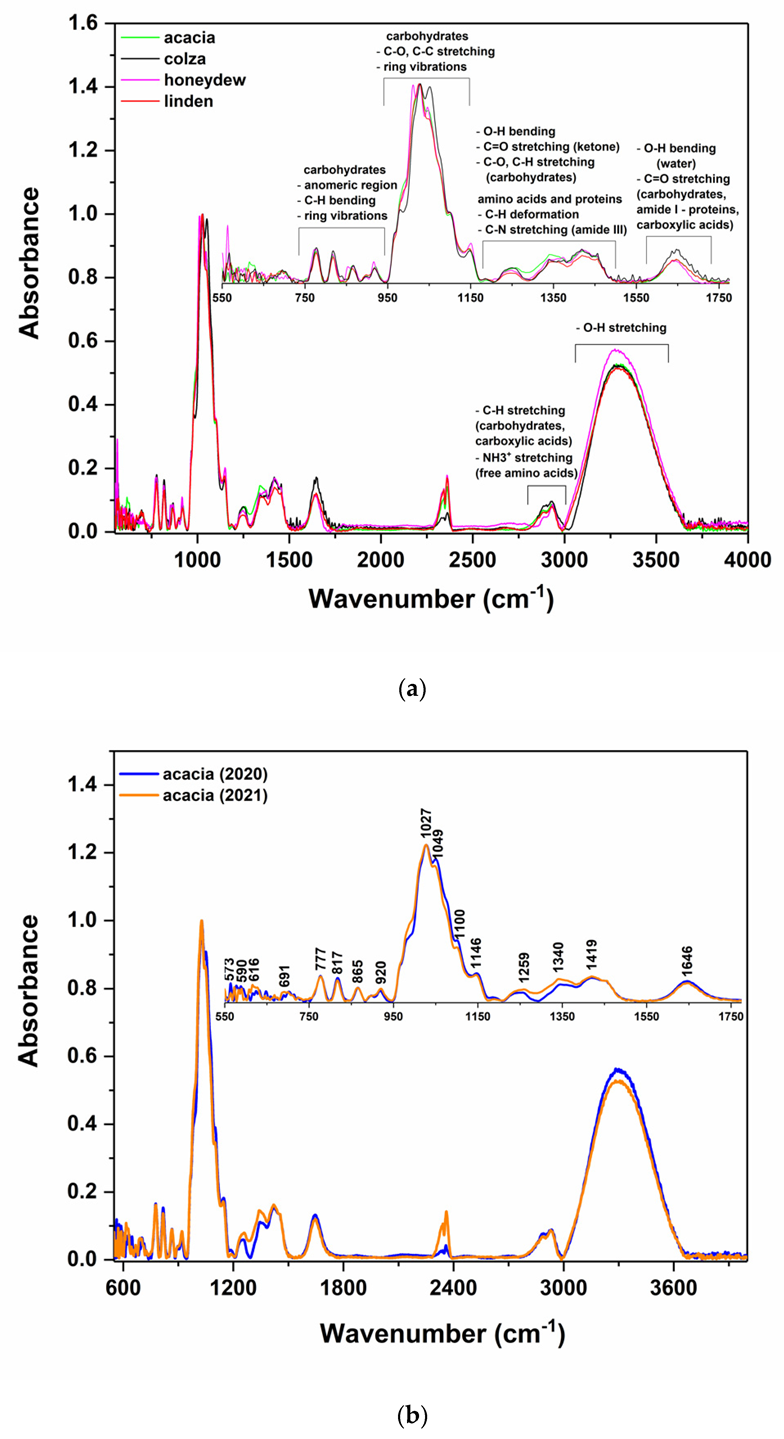
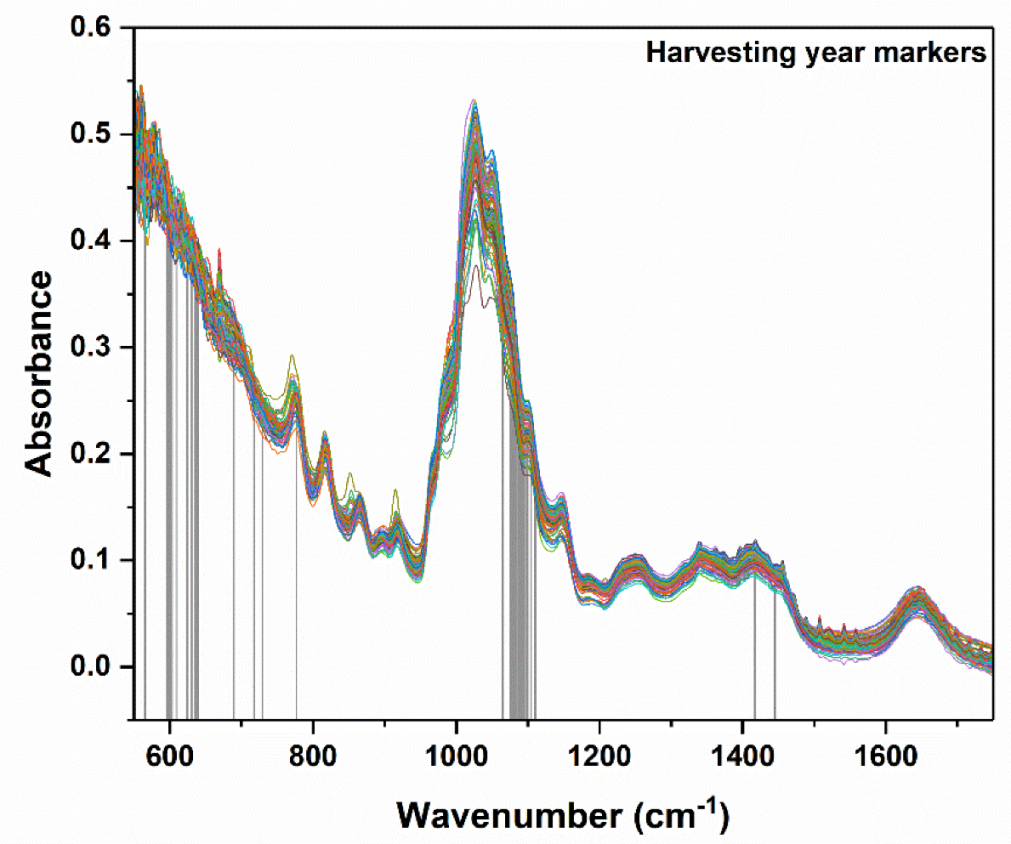

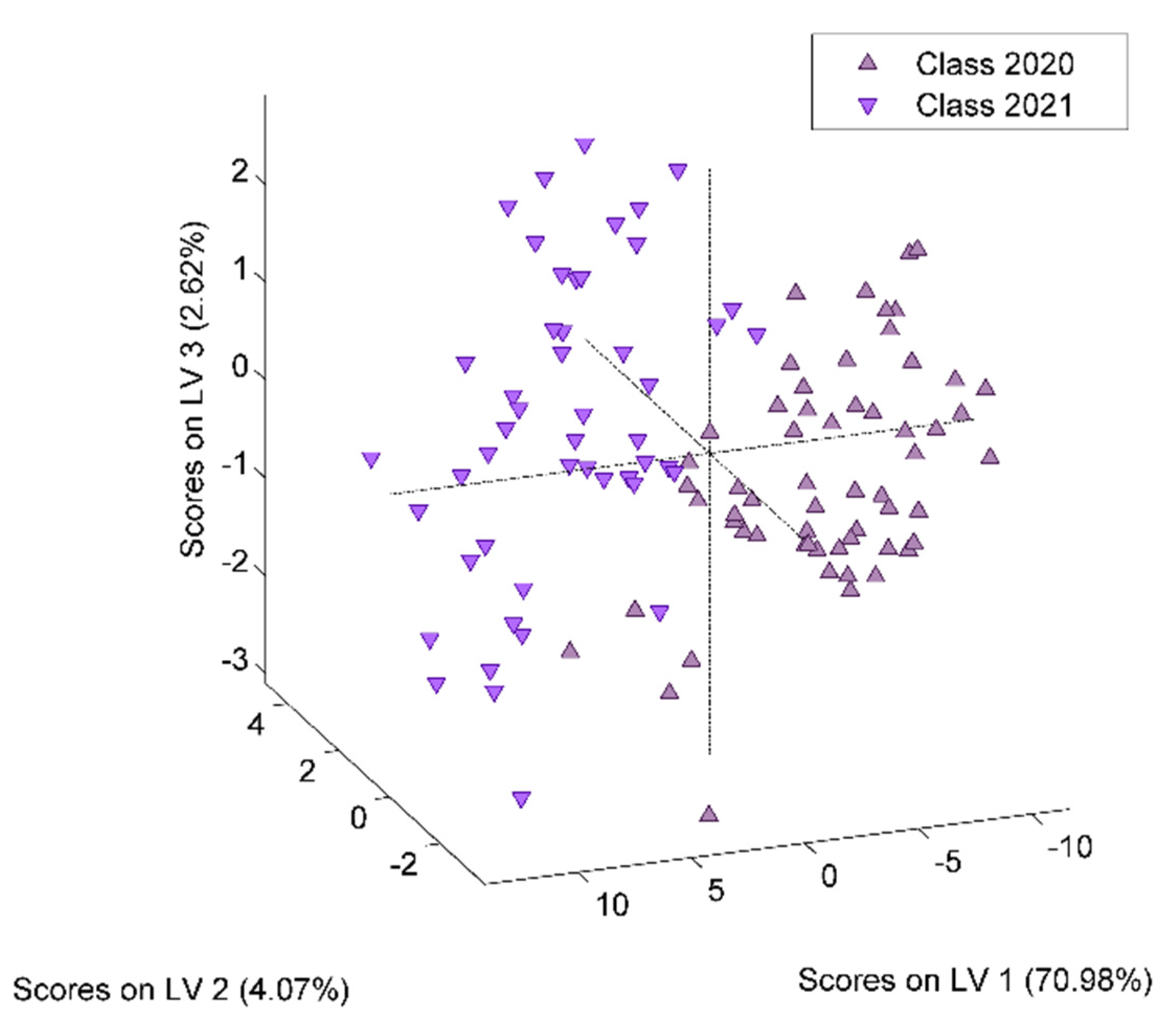
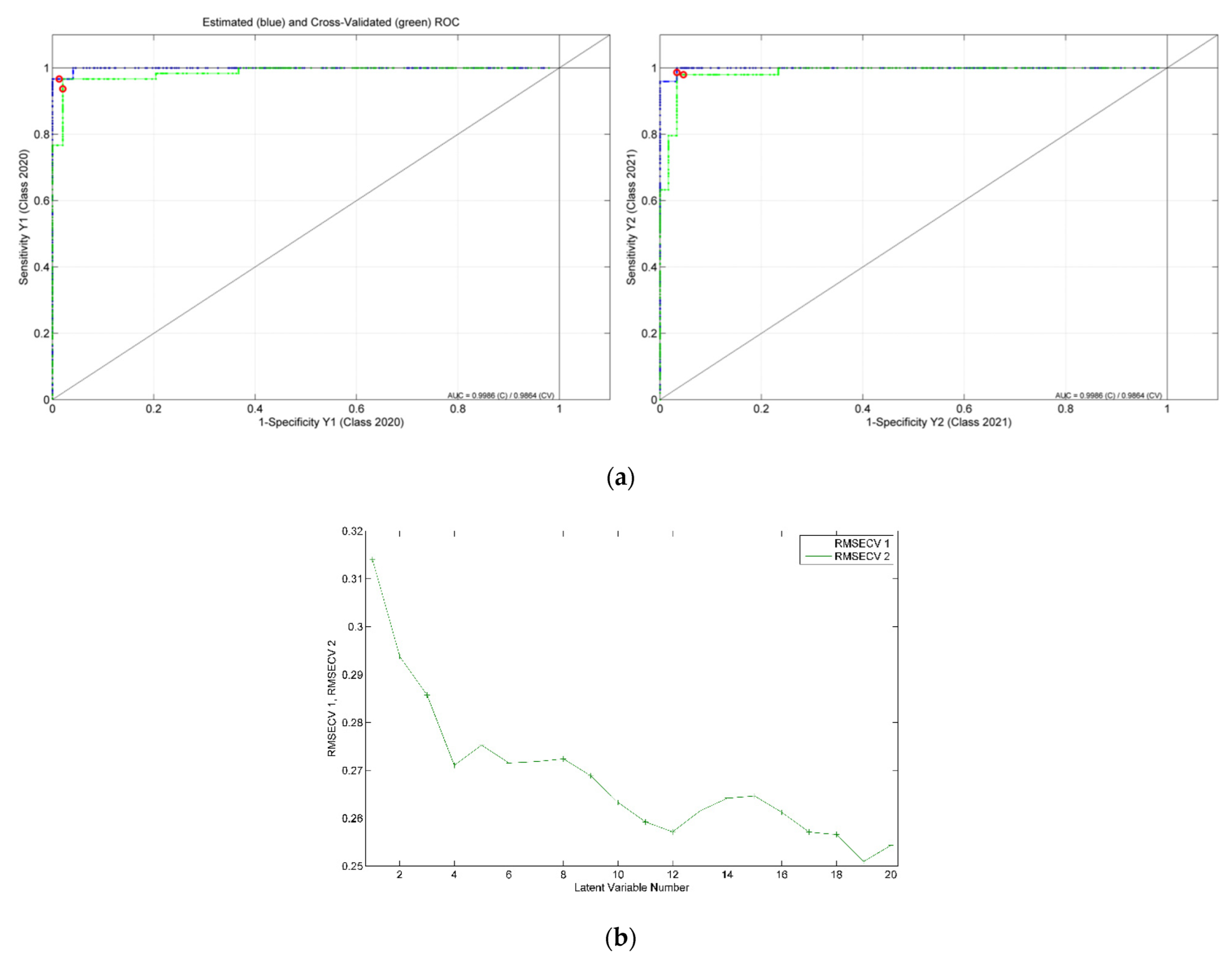

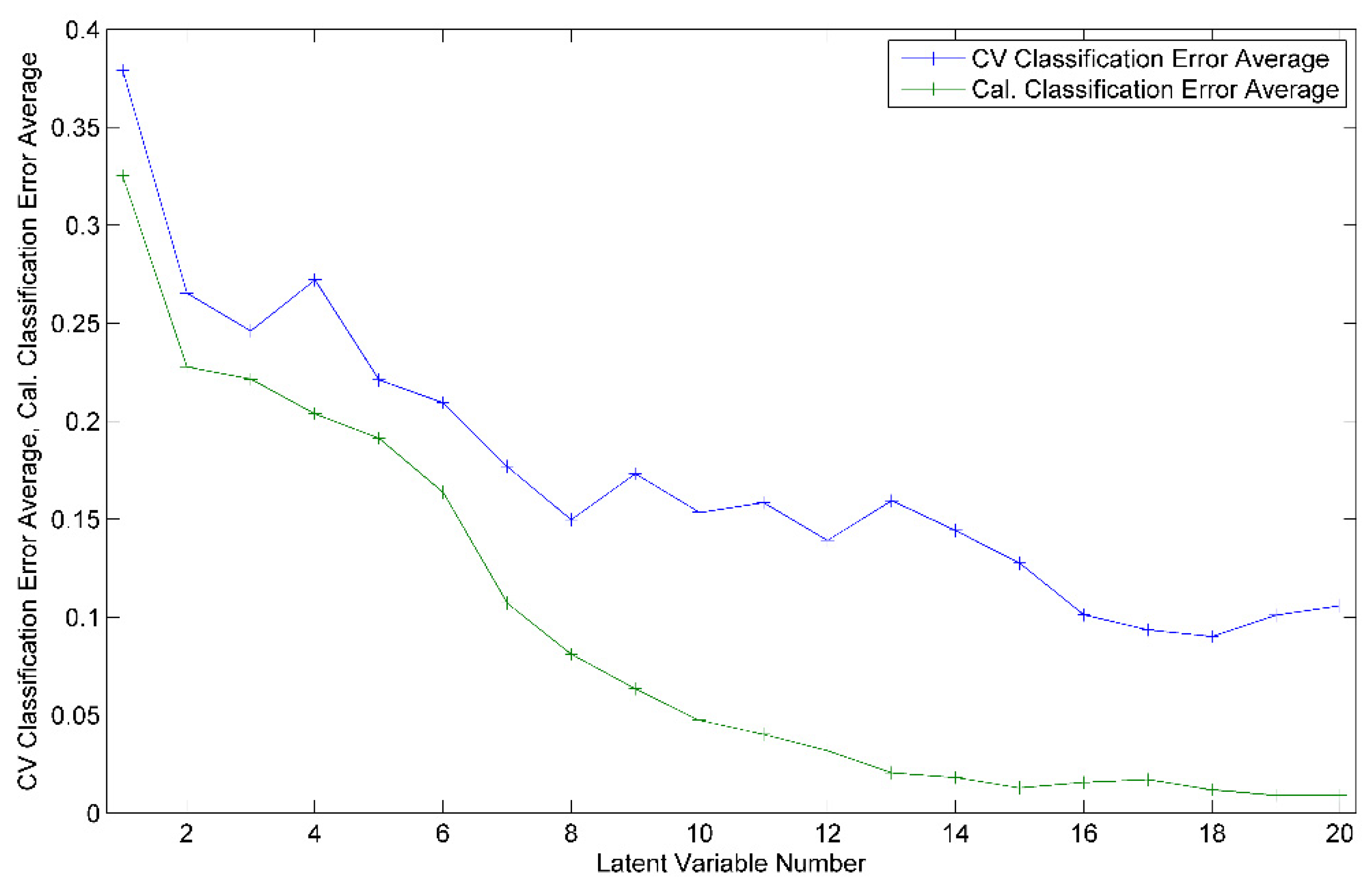

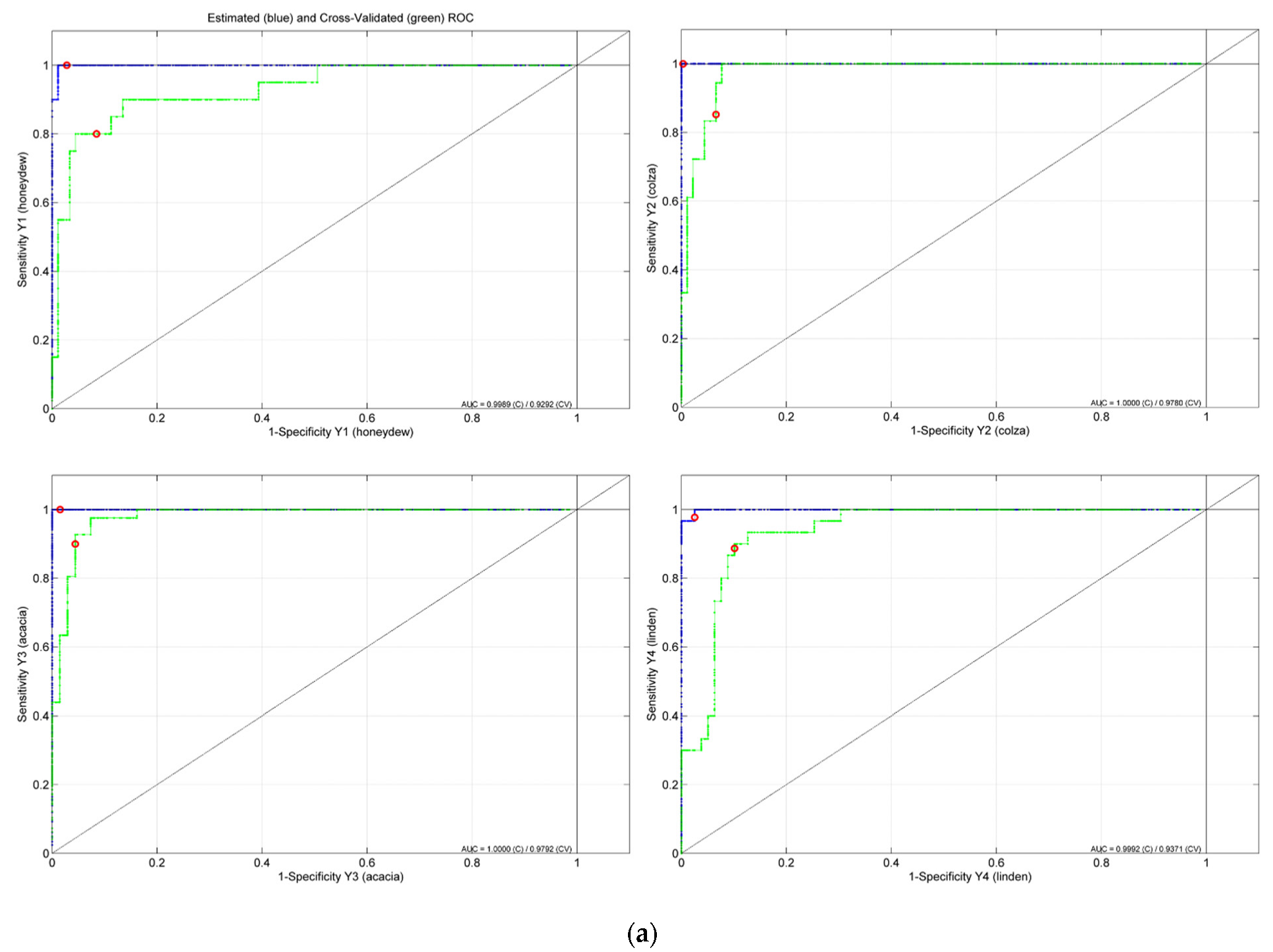
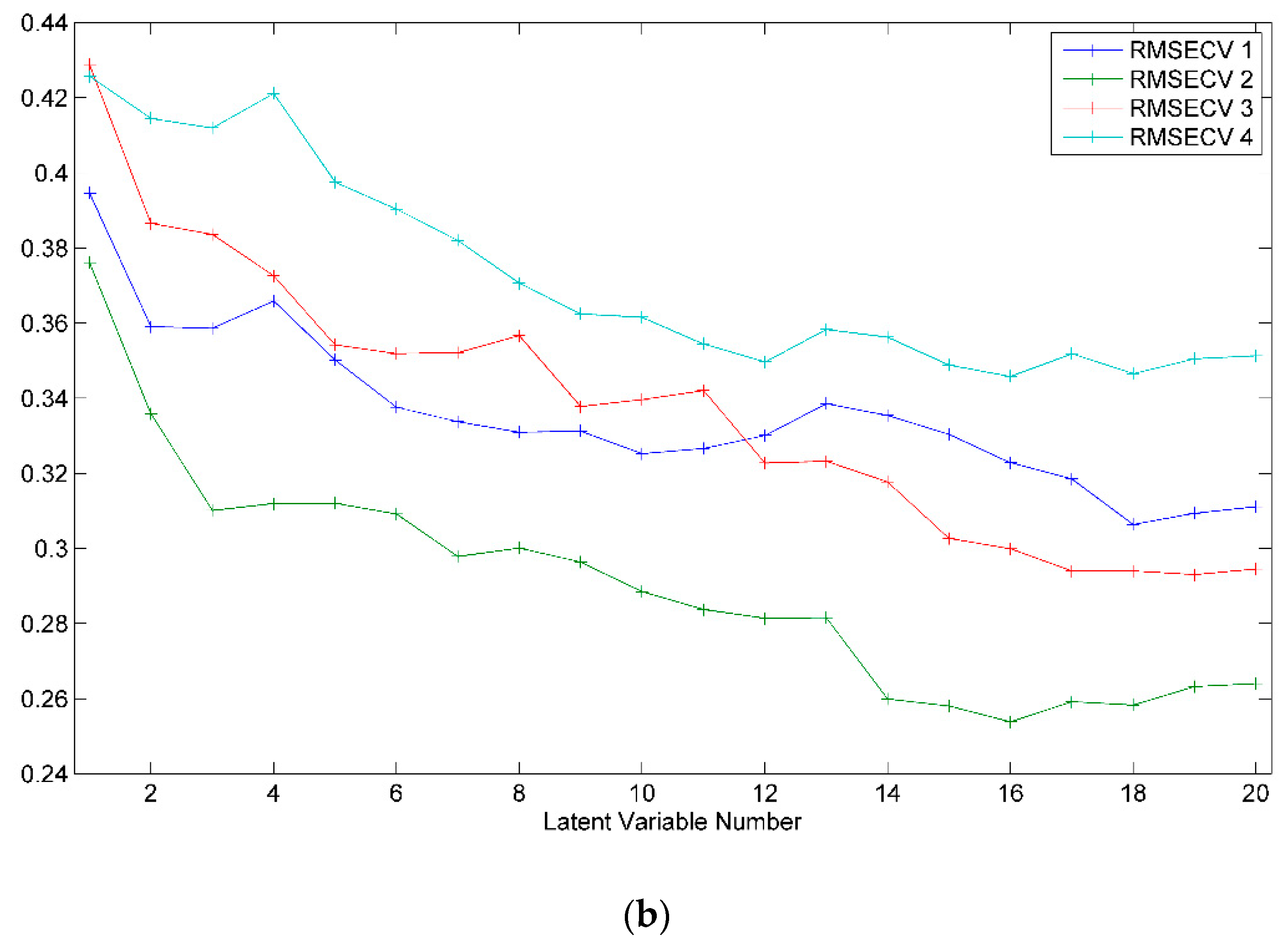
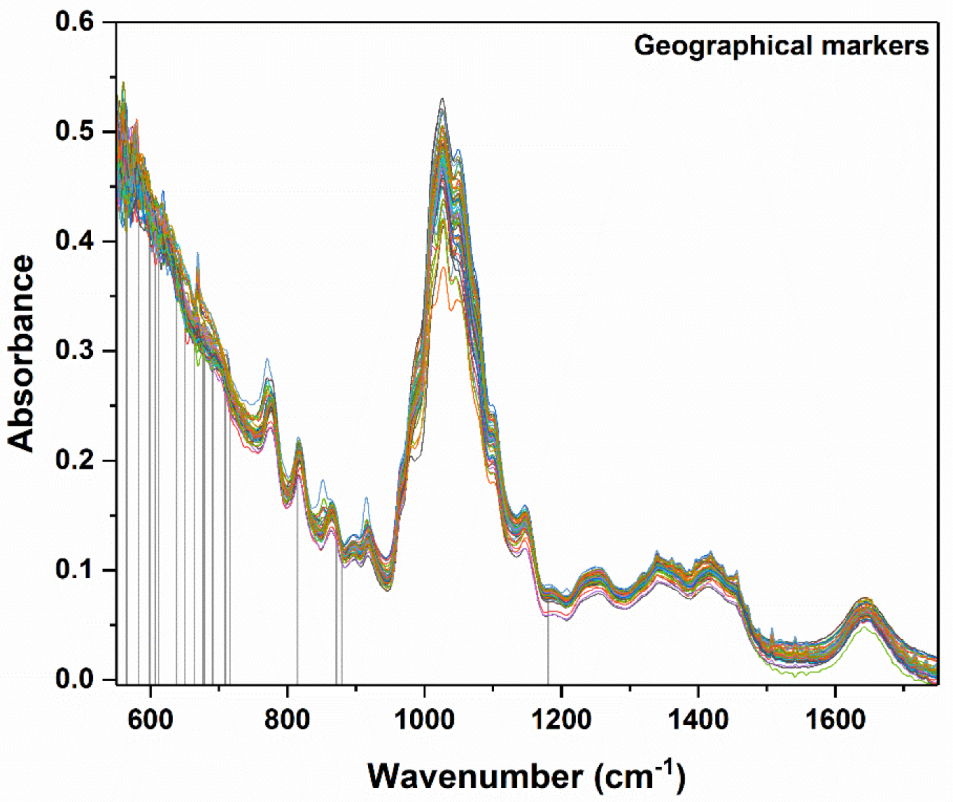
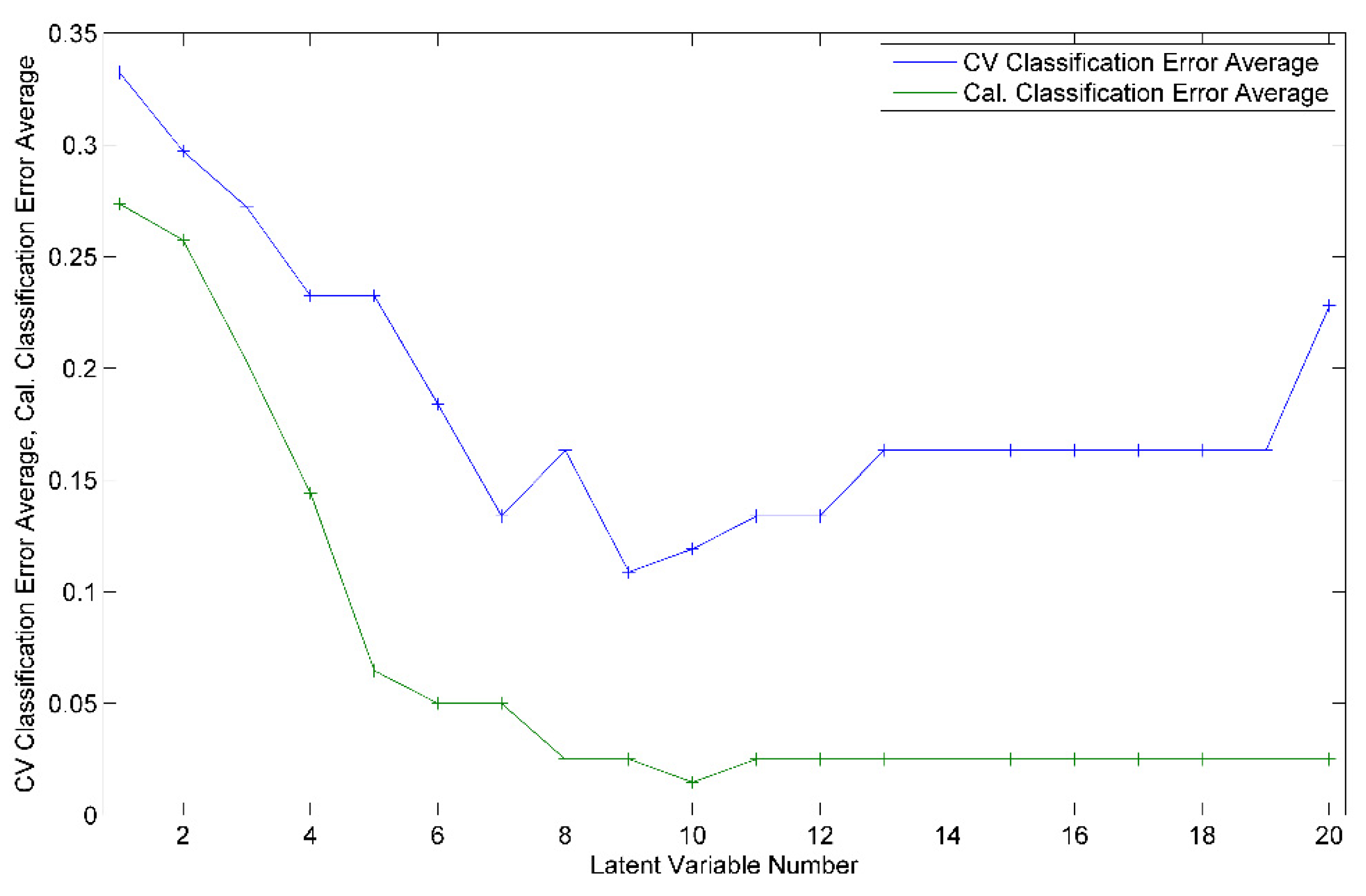

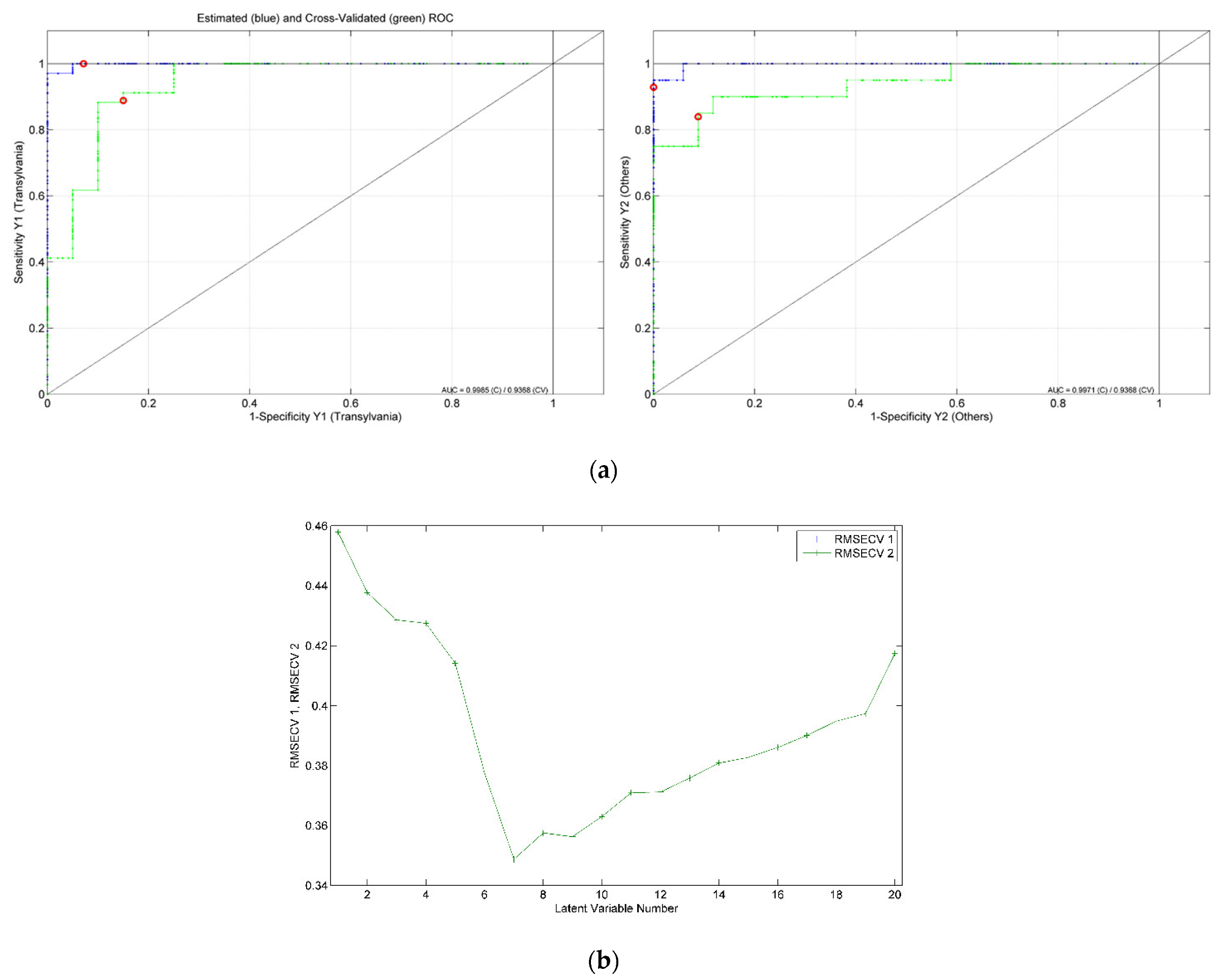
| Botanical Origin | Sample Number | Harvesting Year | Geographical Origin | ||
|---|---|---|---|---|---|
| 2020 | 2021 | Transylvania | Others | ||
| Acacia | 41 | 20 | 21 | 14 | 6 |
| Linden | 30 | 19 | 11 | 7 | 6 |
| Colza | 18 | 8 | 10 | 5 | 4 |
| Honeydew | 20 | 13 | 7 | 8 | 4 |
| Total | 109 | 60 | 49 | 34 | 20 |
Publisher’s Note: MDPI stays neutral with regard to jurisdictional claims in published maps and institutional affiliations. |
© 2022 by the authors. Licensee MDPI, Basel, Switzerland. This article is an open access article distributed under the terms and conditions of the Creative Commons Attribution (CC BY) license (https://creativecommons.org/licenses/by/4.0/).
Share and Cite
David, M.; Hategan, A.R.; Berghian-Grosan, C.; Magdas, D.A. The Development of Honey Recognition Models Based on the Association between ATR-IR Spectroscopy and Advanced Statistical Tools. Int. J. Mol. Sci. 2022, 23, 9977. https://doi.org/10.3390/ijms23179977
David M, Hategan AR, Berghian-Grosan C, Magdas DA. The Development of Honey Recognition Models Based on the Association between ATR-IR Spectroscopy and Advanced Statistical Tools. International Journal of Molecular Sciences. 2022; 23(17):9977. https://doi.org/10.3390/ijms23179977
Chicago/Turabian StyleDavid, Maria, Ariana Raluca Hategan, Camelia Berghian-Grosan, and Dana Alina Magdas. 2022. "The Development of Honey Recognition Models Based on the Association between ATR-IR Spectroscopy and Advanced Statistical Tools" International Journal of Molecular Sciences 23, no. 17: 9977. https://doi.org/10.3390/ijms23179977
APA StyleDavid, M., Hategan, A. R., Berghian-Grosan, C., & Magdas, D. A. (2022). The Development of Honey Recognition Models Based on the Association between ATR-IR Spectroscopy and Advanced Statistical Tools. International Journal of Molecular Sciences, 23(17), 9977. https://doi.org/10.3390/ijms23179977










